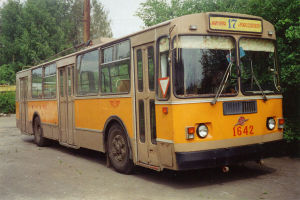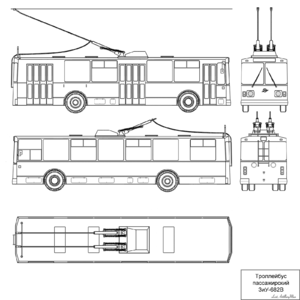
ZiU-9
Encyclopedia

Russia
Russia or , officially known as both Russia and the Russian Federation , is a country in northern Eurasia. It is a federal semi-presidential republic, comprising 83 federal subjects...
n) trolleybus
Trolleybus
A trolleybus is an electric bus that draws its electricity from overhead wires using spring-loaded trolley poles. Two wires and poles are required to complete the electrical circuit...
vehicle. Other names and indexes for the same vehicle include ZiU-682 and HTI-682 (respectively ЗиУ-682 and ХТИ-682 in Russian letters). The ZiU acronym stands for Zavod imeni Uritskogo, which means plant named after Moisei Uritsky
Moisei Uritsky
Moisei Solomonovich Uritsky was a Bolshevik revolutionary leader in Russia.He was born in the city of Cherkasy, Kiev Governorate, to a Jewish family. His father, a merchant, died when Moisei was little and his mother raised her son by herself.Moisei studied law at the University of Kiev...
, the Russian revolutionary. Before 1996 this acronym was also a trademark of the vehicle manufacturer. It has been changed to Trolza. The ZiU-9 was put in mass production in 1971 and it is still assembled along with other more advanced trolleybus vehicles on the Trolza (former ZiU) factory. The total number of produced ZiU-9s exceeds 40,000 vehicles. This model is the most numerous trolleybus vehicle in the world.
History and development

Soviet Union
The Soviet Union , officially the Union of Soviet Socialist Republics , was a constitutionally socialist state that existed in Eurasia between 1922 and 1991....
in the 1960s required a large number of trolleybus vehicles. The mainstay of the contemporary Soviet trolley fleet, the ZiU-5
ZiU-5
The ZiU-5 is the Soviet trolleybus. The ZiU acronym stands for Zavod imeni Uritskogo The ZiU-5 (in Russian ЗиУ-5) is the Soviet trolleybus. The ZiU acronym stands for Zavod imeni Uritskogo The ZiU-5 (in Russian ЗиУ-5) is the Soviet trolleybus. The ZiU acronym stands for Zavod imeni Uritskogo...
, was not sufficient for huge urban passenger transfers. It was more suited for medium-size cities rather than large megapolises such as Moscow
Moscow
Moscow is the capital, the most populous city, and the most populous federal subject of Russia. The city is a major political, economic, cultural, scientific, religious, financial, educational, and transportation centre of Russia and the continent...
or Saint Petersburg
Saint Petersburg
Saint Petersburg is a city and a federal subject of Russia located on the Neva River at the head of the Gulf of Finland on the Baltic Sea...
. In addition the ZiU-5 had an aluminium
Aluminium
Aluminium or aluminum is a silvery white member of the boron group of chemical elements. It has the symbol Al, and its atomic number is 13. It is not soluble in water under normal circumstances....
hull, which was expensive and complicated from a technological point of view. The two doors in the ZiU-5 hull ends did not work well in overcrowded situations which were quite common in Soviet public transportation.
The ZiU-9 was a quite successful attempt to solve this problems. It has one extra door compared to the ZiU-5. Two doors are wide and placed in the middle and rear end of the vehicle hull. One small door in the front end of the vehicle was/is comfortable for the driver and for outgoing passengers. The hull of the ZiU-9 is a welded steel
Steel
Steel is an alloy that consists mostly of iron and has a carbon content between 0.2% and 2.1% by weight, depending on the grade. Carbon is the most common alloying material for iron, but various other alloying elements are used, such as manganese, chromium, vanadium, and tungsten...
one and it is significantly cheaper and simpler in production than the hull of the ZiU-5. The external appearance of the ZiU-9 was influenced by contemporary German-made MAN trolleybuses.

Resistor
A linear resistor is a linear, passive two-terminal electrical component that implements electrical resistance as a circuit element.The current through a resistor is in direct proportion to the voltage across the resistor's terminals. Thus, the ratio of the voltage applied across a resistor's...
-based control system of electric current
Electric current
Electric current is a flow of electric charge through a medium.This charge is typically carried by moving electrons in a conductor such as wire...
was slightly modified to deal with the increased power of the main motor. While western designers developed new semiconductor
Semiconductor
A semiconductor is a material with electrical conductivity due to electron flow intermediate in magnitude between that of a conductor and an insulator. This means a conductivity roughly in the range of 103 to 10−8 siemens per centimeter...
-based control devices, Soviet engineers decided to leave the old resistor-based system for service simplicity. The first prototype vehicles were tested in Moscow in 1971 and were approved for mass production after some minor design adjustments.
The '9' in the vehicle name was the initial project index of the design team. However, after launching mass production, the new trolleybus received a new index '682' from the united classification of non-rail public transport vehicles. So all series vehicles had a ZiU-682 designation. But the number 682 is difficult to pronounce and the shorter '9' still lives in the everyday language of drivers and servicemen. In 1986, the new classification was introduced and the former ZiU-682 was designated as HTI-682. But this was not an end of renaming the same vehicle. The Russian acronym HTI in the Cyrillic alphabet is ХТИ and these three Cyrillic letters in 1995 were confused with the Latin letters XTU. This Latin acronym became an official name of the vehicle.
Modifications
During mass-production there were some improvements of the ZiU-9 design. Any major change is designated by a letter after the '9' or '682' index:- (1971) ZiU-9 - first prototype vehicles
- (1972) ZiU-9B (ЗиУ-9Б) - first large-series vehicles
- (1976) ZiU-9V (ЗиУ-9В) - major improvements in electric equipment
ZiU-9G / ZiU-682G / ЗиУ-9Г Modification (1992)
- door gear was changed from electric to pneumatic, the vehicle frame was lightened, so the active service life became shorter.
- By the late 1980s separate elements of trolleybus construction, which were released on that moment were 20 years old, and became significantly obsolete. That's why meanwhile with the release of last ZIU-682V copies, the manufacturers prepared to a much deeper level of modernizations, designated as ZIU-682G ЗиУ-682Г. Experimental copies of ZIU 682G ЗиУ-682Г were released still in 1988, and starting with February 1,1991 the manufacturer switched completely to the production of ZIU 682G model.
This variant is in mass-production now, the cheapest trolleybus in the domestic market of Russia. The full official name with minor improvement designations is XTU-682ГОЕ-012.
Many factories in modern Russia
Russia
Russia or , officially known as both Russia and the Russian Federation , is a country in northern Eurasia. It is a federal semi-presidential republic, comprising 83 federal subjects...
or Belarus
Belarus
Belarus , officially the Republic of Belarus, is a landlocked country in Eastern Europe, bordered clockwise by Russia to the northeast, Ukraine to the south, Poland to the west, and Lithuania and Latvia to the northwest. Its capital is Minsk; other major cities include Brest, Grodno , Gomel ,...
developed their unlicensed or semi-licenced copies of the ZiU-9 design. They may have different designations and trademarks, but in the colloquial language all of them are referred to as "ZiU-9 clones".
Operators
ZiU-9s worked or are now working in all ex-USSR countries except the Baltic states. They were also sold to GreeceGreece
Greece , officially the Hellenic Republic , and historically Hellas or the Republic of Greece in English, is a country in southeastern Europe....
, Argentina
Argentina
Argentina , officially the Argentine Republic , is the second largest country in South America by land area, after Brazil. It is constituted as a federation of 23 provinces and an autonomous city, Buenos Aires...
, in Colombia
Colombia
Colombia, officially the Republic of Colombia , is a unitary constitutional republic comprising thirty-two departments. The country is located in northwestern South America, bordered to the east by Venezuela and Brazil; to the south by Ecuador and Peru; to the north by the Caribbean Sea; to the...
the EDTA (Empresa Distrital de Transportes Asociados) was a larger operator of these buses; they was in a very bad conservation state, and the former Eastern Bloc countries. Three cars were on loan in 1973 for testing purposes in Helsinki
Helsinki
Helsinki is the capital and largest city in Finland. It is in the region of Uusimaa, located in southern Finland, on the shore of the Gulf of Finland, an arm of the Baltic Sea. The population of the city of Helsinki is , making it by far the most populous municipality in Finland. Helsinki is...
, Finland
Finland
Finland , officially the Republic of Finland, is a Nordic country situated in the Fennoscandian region of Northern Europe. It is bordered by Sweden in the west, Norway in the north and Russia in the east, while Estonia lies to its south across the Gulf of Finland.Around 5.4 million people reside...
. In 2004, the ILPAP
ILPAP
I.L.P.A.P. was a public Greek company, part of the general Athens Mass Transit System, responsible for the operation of the trolleybuses network...
, the operator of trolleybusses in Athens
Athens
Athens , is the capital and largest city of Greece. Athens dominates the Attica region and is one of the world's oldest cities, as its recorded history spans around 3,400 years. Classical Athens was a powerful city-state...
, Greece donated nearly all of its old ZiU-9 trolleybuses to the city of Belgrade
Belgrade
Belgrade is the capital and largest city of Serbia. It is located at the confluence of the Sava and Danube rivers, where the Pannonian Plain meets the Balkans. According to official results of Census 2011, the city has a population of 1,639,121. It is one of the 15 largest cities in Europe...
, although Belgrade had ZiU-9 trolleys of its own since late 1970s. In 2010 a public action was taken to save Belgrade's first ZiU-9 from being sold to scrapyard. One was donated to the East Anglia Transport Museum
East Anglia Transport Museum
The East Anglia Transport Museum is an open air transport museum, with numerous historic public transport vehicles . It is located in Carlton Colville a suburb of Lowestoft, Suffolk...
.
In Hungary
Hungary
Hungary , officially the Republic of Hungary , is a landlocked country in Central Europe. It is situated in the Carpathian Basin and is bordered by Slovakia to the north, Ukraine and Romania to the east, Serbia and Croatia to the south, Slovenia to the southwest and Austria to the west. The...
, Ziu-9 trolleys still operate in Budapest
Budapest
Budapest is the capital of Hungary. As the largest city of Hungary, it is the country's principal political, cultural, commercial, industrial, and transportation centre. In 2011, Budapest had 1,733,685 inhabitants, down from its 1989 peak of 2,113,645 due to suburbanization. The Budapest Commuter...
(BKV
BKV
BKV is the unified public transport company of Budapest, established in 1968...
), Debrecen
Debrecen
Debrecen , is the second largest city in Hungary after Budapest. Debrecen is the regional centre of the Northern Great Plain region and the seat of Hajdú-Bihar county.- Name :...
(DKV) and used to operate in Szeged
Szeged
' is the third largest city of Hungary, the largest city and regional centre of the Southern Great Plain and the county town of Csongrád county. The University of Szeged is one of the most distinguished universities in Hungary....
(SzKT).
External links
- ZiU-9 on the Nizhny Novgorod tram site (in Russian)
- Trolleybus in Budapest - Ziu 9 trolibuses (English, somewhat dated)

